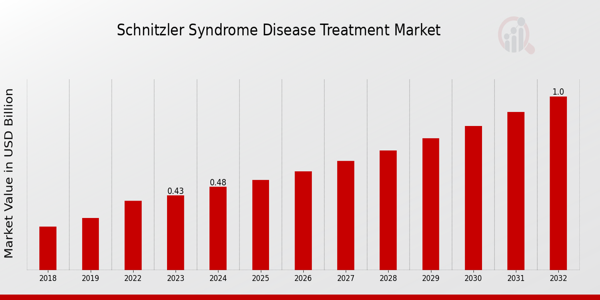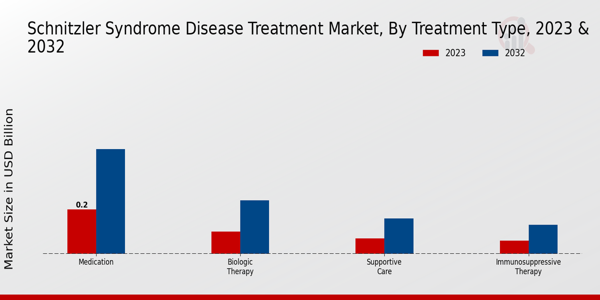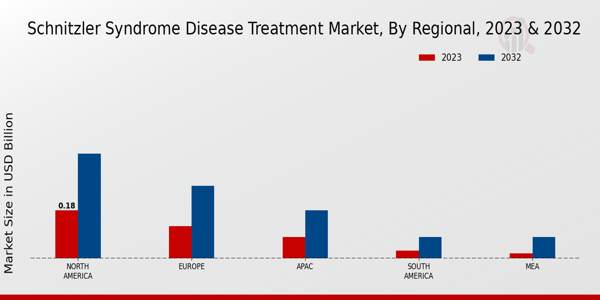Global Schnitzler Syndrome Disease Treatment Market Overview
As per MRFR analysis, the Schnitzler Syndrome Disease Treatment Market Size was estimated at 0.53 (USD Billion) in 2024. The Schnitzler Syndrome Disease Treatment Market Industry is expected to grow from 0.58 (USD Billion) in 2025 to 1.34 (USD Billion) till 2034, at a CAGR (growth rate) is expected to be around 9.72% during the forecast period (2025 - 2034).
Key Schnitzler Syndrome Disease Treatment Market Trends Highlighted
The Schnitzler Syndrome Disease Treatment Market is growing rapidly owing to a number of factors. The rise in awareness among the healthcare professionals regarding Schnitzler syndrome is resulting in early diagnosis and improved treatment. Besides that, recent breakthroughs in medical research and technology have opened the doors for new therapies attaining a greater range of treatment options. The increase in healthcare research funding though is also critical in disease comprehension and proper drug development. Some of the opportunities to be harnessed in this market are development of new therapies that focus on treatment of specific signs of Schnitzler syndrome.
Biologics and targeted therapies are on the rise as they present new hope for patients who do not respond well to traditional therapies. Also, the rising focus on personalized medicine creates opportunities for designing specific treatment plans that can be more effective. Partnerships between drug manufacturers and research institutions may also improve the drug development funnel, increasing treatment options available. There is a current trend towards a more integrative view of Schnitzler syndrome management, with a pronounced emphasis towards the improvement of patient’s quality of life. Supportive treatment in addition to pharmacological therapy is increasingly being appreciated.
Moreover, the roles and responsibilities of patient advocacy groups are changing, and these organizations are also active participants in research and awareness generation initiatives which allows the voices of people suffering with the syndrome to be heard. New digital health technologies, such as telehealth systems, are also contributing to the enhancement of care delivery and management processes. All in all, the Schnitzler Syndrome Disease Treatment Market is maturing as it adjusts to the new realities and trustworthiness in the delivery of care to the patients.

Source: Primary Research, Secondary Research, MRFR Database and Analyst Review
Schnitzler Syndrome Disease Treatment Market Drivers
Increased Awareness and Diagnosis of Schnitzler Syndrome
One of the most significant drivers of the Schnitzler Syndrome Disease Treatment Market Industry is the increased awareness and diagnosis of Schnitzler syndrome. As more healthcare providers and patients become knowledgeable about this rare disease, the identification rate is on the rise. This heightened awareness leads to more patients being diagnosed and subsequently seeking treatments. Historically, Schnitzler syndrome has been underdiagnosed due to its rarity and the nonspecific nature of initial symptoms, which often leads to misdiagnosis.However, medical advancements and educational efforts have improved diagnostic criteria, allowing healthcare practitioners to correctly identify patients earlier in their disease progression. As diagnostic tools become more refined and accessible, healthcare professionals are capable of conducting comprehensive evaluations that can yield quicker and more precise diagnoses. This surge in diagnosis will inherently increase the demand for treatment options.The Schnitzler Syndrome Disease Treatment Market Industry is thus benefitting from the interaction between improving awareness and the healthcare system's ability to treat previously overlooked conditions. Additionally, the rise in patient advocacy groups has played a crucial role, as these organizations contribute to awareness campaigns and educational programs that inform both individuals and medical professionals about Schnitzler syndrome.These campaigns emphasize the symptoms, risks, and treatment options available, ultimately encouraging affected individuals to seek medical advice and challenging healthcare providers to consider more accurate diagnoses. The ripple effect of these initiatives leads to a greater number of patients entering the treatment phase, driving market growth in the coming years.
Developments in Therapeutic Options
The ongoing developments in therapeutic options represent another key driver for the Schnitzler Syndrome Disease Treatment Market Industry. Advances in biotechnology and pharmaceutical research are yielding new treatments that target the complex mechanisms underlying Schnitzler syndrome. With innovative therapies being introduced, patients have an expanding array of effective treatment choices. This evolution in the treatment landscape not only addresses the unmet medical needs of patients but also attracts investment in research and development activities focused on Schnitzler syndrome.Such investments are essential for the continuous evolution and improvement of available treatments, which can ultimately enhance patient outcomes.
Stronger Regulatory Support and Incentives
Stronger regulatory support and incentives for the development of orphan drugs significantly contribute to the growth of the Schnitzler Syndrome Disease Treatment Market Industry. Many countries have established frameworks that facilitate faster approval for treatments targeting rare diseases, thereby encouraging pharmaceutical companies to invest in research and development. This supportive regulatory environment not only promotes innovation but also ensures that patients have quicker access to new therapies.
Schnitzler Syndrome Disease Treatment Market Segment Insights
Schnitzler Syndrome Disease Treatment Market Treatment Type Insights
The Schnitzler Syndrome Disease Treatment Market is segmented into distinct treatment types, which include Medication, Biologic Therapy, Supportive Care, and Immunosuppressive Therapy, each catering to unique therapeutic needs. In 2023, the Medication category holds a significant position, valued at 0.2 USD Billion, and is projected to increase to 0.47 USD Billion by 2032, demonstrating its substantial majority in the treatment landscape. This growth is largely attributed to the demand for effective pharmacological solutions in managing Schnitzler Syndrome, thereby driving the overall market growth.Biologic Therapy, coming in second with a valuation of 0.1 USD Billion in 2023 and a projected rise to 0.24 USD Billion by 2032, represents an essential treatment avenue that harnesses the body’s immune system, further highlighting its significance in addressing this complex disease. Supportive Care deemed critical for improving patients’ quality of life, is valued at 0.07 USD Billion in 2023, with estimates pushing it to 0.16 USD Billion by 2032, thus underscoring its growing importance in holistic treatment approaches. Although Immunosuppressive Therapy currently ranks as the least dominant segment, valued at 0.06 USD Billion in 2023 and expected to reach 0.13 USD Billion by 2032, it still plays a vital role in controlling the autoimmune aspects of Schnitzler Syndrome.Each treatment type significantly contributes to the overall treatment strategy as the global demand for effective solutions increases, driven by rising awareness and diagnosis of this rare condition alongside improvements in healthcare access. The market statistics reinforce that Medication and Biologic Therapy dominate the treatment landscape, making them pivotal in addressing the needs of patients with Schnitzler Syndrome, while Supportive Care and Immunosuppressive Therapy further enhance the therapeutic options available. Overall insights indicate a progressive expansion across all treatment types, reflecting the importance of comprehensive management strategies tailored to patient needs.

Source: Primary Research, Secondary Research, MRFR Database and Analyst Review
Schnitzler Syndrome Disease Treatment Market Administration Route Insights
The Administration Route segment of the Schnitzler Syndrome Disease Treatment Market plays a crucial role in shaping treatment protocols and patient outcomes. In 2023, the market was valued at 0.43 Billion USD, and it is projected to continue to grow significantly over the coming years. Within this segment, various methods such as Oral, Subcutaneous, Intravenous, and Intramuscular administration are utilized, each offering distinct advantages based on patient needs and treatment efficacy. Oral administration typically dominates due to its convenience and ease of use, making it the preferred choice for many patients.Subcutaneous routes also hold significant importance, often preferred for self-administration and enhancing patient compliance. Intravenous and Intramuscular routes, while used less frequently, are essential for cases requiring rapid drug absorption and immediate therapeutic effects. The continued growth of the Schnitzler Syndrome Disease Treatment Market is driven by advancements in these administration methods, alongside increased awareness and diagnosis of Schnitzler Syndrome. As healthcare providers seek to optimize treatment regimens, the Administration Route segment is expected to see innovative developments that cater to diverse patient requirements.Understanding this segment's dynamics is vital for stakeholders aiming to tap into the expanding market.
Schnitzler Syndrome Disease Treatment Market End User Insights
The Schnitzler Syndrome Disease Treatment Market is witnessing substantial growth across various End User sectors, contributing to the overall market. As of 2023, the market is valued at USD 0.43 Billion and is projected to be USD 1.0 Billion by 2032, reflecting a strong demand for treatment options. Hospitals have emerged as a significant contributor, given their capacity to provide specialized care and advanced treatment protocols. Clinics also play a vital role, offering accessible treatment options to a broad patient base, and enhancing patient engagement and follow-up care.Homecare services have gained traction, particularly due to their convenience and personalized approach, catering to patients who prefer treatment in a familiar environment. Research Institutions are crucial for innovation in treatment methodologies, driving the development of new therapeutic options through clinical trials and studies. This segmentation showcases the diversity of treatment avenues available for Schnitzler Syndrome, illustrating its importance in improving patient outcomes while contributing to the Schnitzler Syndrome Disease Treatment Market revenue growth.As the market continues to expand, opportunities for collaboration among these sectors will likely foster advancements in treatment solutions.
Schnitzler Syndrome Disease Treatment Market Disease Stage Insights
The Schnitzler Syndrome Disease Treatment Market is segmented by Disease Stage, reflecting the varying intensity and frequency of the disease. As of 2023, the market value stands at 0.43 USD Billion, with projections to reach 1.0 USD Billion by 2032, showcasing significant market growth potential. Each disease stage presents unique challenges and treatment requirements, driving demand for tailored therapeutic approaches. The Early Stage of Schnitzler Syndrome represents a crucial period for intervention, as timely treatment can prevent disease progression.The Moderate Stage sees an increase in symptom severity, requiring more focused management strategies, while the Severe Stage is characterized by pronounced symptoms needing intensive care. The Recurrent Stage is particularly important as it highlights the chronic nature of the disease, necessitating ongoing treatment solutions for long-term patient management. Collectively, these stages inform the Schnitzler Syndrome Disease Treatment Market segmentation, emphasizing the need for diverse therapeutic options that align with the disease's evolution and patient needs.As the market progresses, understanding these stages will be vital for addressing treatment challenges and capturing opportunities within this niche segment.
Schnitzler Syndrome Disease Treatment Market Regional Insights
The Schnitzler Syndrome Disease Treatment Market demonstrated a valuation of 0.43 USD Billion in 2023, reflecting a growing interest in this niche medical condition. Within the regional segmentation, North America leads with a substantial contribution of 0.18 USD Billion in 2023, which is anticipated to grow to 0.39 USD Billion by 2032, indicating the majority holding due to advanced healthcare infrastructure and increased awareness. Europe follows with a valuation of 0.12 USD Billion in 2023 and is expected to reach 0.27 USD Billion by 2032, highlighting its significant role driven by extensive research and development efforts.The APAC region is also noteworthy, valued at 0.08 USD Billion in 2023 and forecasted to grow to 0.18 USD Billion in 2032, showcasing emerging market potential as healthcare access improves. South America represents a smaller share at 0.03 USD Billion in 2023, with an expected increase to 0.08 USD Billion by 2032, indicating a developing landscape. Meanwhile, the MEA region, valued at 0.02 USD Billion in 2023 with a projected rise to 0.08 USD Billion, suggests that while it currently holds the least market share, it still presents growth opportunities.Overall, the Schnitzler Syndrome Disease Treatment Market revenue illustrates varied dynamics across regions, with North America and Europe dominating, reflecting higher patient populations and research initiatives.

Source: Primary Research, Secondary Research, MRFR Database and Analyst Review
Schnitzler Syndrome Disease Treatment Market Key Players and Competitive Insights
The Schnitzler Syndrome Disease Treatment Market is characterized by a dynamic and competitive landscape, where pharmaceutical companies are actively engaged in research and development to provide effective therapeutics for this rare but debilitating condition. The market is influenced by various factors, including advancements in medical research, increasing awareness of rare diseases, and the development of targeted therapies that can alleviate symptoms. Moreover, stakeholders in the market are focused on establishing partnerships, collaborations, and mergers and acquisitions in order to enhance their product offerings and expand their market reach. As the healthcare sector increasingly recognizes the need for specialized treatments for conditions like Schnitzler Syndrome, attention is turning toward innovative solutions that promise better patient outcomes and more efficient management of the disease.Merck and Co are notable for their robust presence in the Schnitzler Syndrome Disease Treatment Market, standing out due to their impressive portfolio and commitment to addressing rare diseases. The company has leveraged its extensive expertise in immunology and biopharmaceuticals, focusing on developing therapies that target the underlying mechanisms of Schnitzler Syndrome. Merck and Co. have established collaborations with research institutions and healthcare providers, which reinforces their strength in creating synergies for clinical trials and product development. In addition, the company has made significant investments in research, allowing it to stay at the forefront of scientific advancements. With an established distribution network and strong brand recognition, Merck and Co. are well-positioned to capitalize on market opportunities, providing patients with essential treatment options and enhancing their quality of life.Pfizer is another key player in the Schnitzler Syndrome Disease Treatment Market, known for its dedication to innovation and a patient-centric approach to drug development. The company has made substantial progress in understanding Schnitzler Syndrome, which is reflected in its pipeline focused on emerging therapies aimed at alleviating the symptoms associated with this rare condition. Pfizer's extensive research capabilities and experience in both large-scale drug manufacturing and specialty pharmaceuticals give it an edge in efficiently bringing new treatments to market. The firm is adept at navigating the complexities of regulatory approval processes, which facilitates timely access to essential therapies for patients. With a strong emphasis on collaboration with healthcare providers and an unwavering commitment to improving patient outcomes, Pfizer is strategically positioned to make a significant impact in the Schnitzler Syndrome treatment landscape.
Key Companies in the Schnitzler Syndrome Disease Treatment Market Include
- Merck and Co
- Pfizer
- Amgen
- Eli Lilly and Company
- Takeda Pharmaceutical Company
- AbbVie
- Teva Pharmaceutical Industries
- Mylan N.V.
- Roche
- Johnson and Johnson
- AstraZeneca
- Novartis
- BristolMyers Squibb
- Gilead Sciences
- Sanofi
Schnitzler Syndrome Disease Treatment Market Industry Developments
Recent developments in the Schnitzler Syndrome Disease Treatment Market have highlighted significant advancements and ongoing research initiatives. Merck & Co., Pfizer, and Amgen are focusing on expanding their therapeutic portfolios for rare diseases, including Schnitzler Syndrome, reflecting a trend toward niche market engagement. Eli Lilly and Takeda Pharmaceutical Company are actively involved in clinical trials aimed at improving treatment protocols and enhancing patient outcomes. AbbVie and Roche are enhancing their collaboration in research and development to explore new therapeutic avenues, while Johnson & Johnson and AstraZeneca are investing in cutting-edge biotechnology solutions related to the condition. Furthermore, Novartis and Bristol-Myers Squibb are closely monitoring market dynamics, which includes potential mergers and acquisitions, as they seek to strengthen their positions in this specialized field. Gilead Sciences and Sanofi are strategically positioning themselves to capitalize on the increasing market valuation driven by rising patient awareness and therapeutic demand within the Schnitzler Syndrome sphere. The collaborative efforts across these companies are expected to foster innovation and accelerate the development of effective treatments, ultimately influencing market growth positively.
- Schnitzler Syndrome Disease Treatment Market Segmentation Insights
- Schnitzler Syndrome Disease Treatment Market Treatment Type Outlook
- Medication
- Biologic Therapy
- Supportive Care
- Immunosuppressive Therapy
- Schnitzler Syndrome Disease Treatment Market Administration Route Outlook
- Oral
- Subcutaneous
- Intravenous
- Intramuscular
- Schnitzler Syndrome Disease Treatment Market End User Outlook
- Hospitals
- Clinics
- Homecare
- Research Institutions
- Schnitzler Syndrome Disease Treatment Market Disease Stage Outlook
- Early Stage
- Moderate Stage
- Severe Stage
- Recurrent Stage
| Report Attribute/Metric |
Details |
|
Market Size 2024
|
0.53 (USD Billion)
|
|
Market Size 2025
|
0.58 (USD Billion)
|
|
Market Size 2034
|
1.34 (USD Billion)
|
|
Compound Annual Growth Rate (CAGR)
|
9.72 % (2025 - 2034)
|
|
Report Coverage
|
Revenue Forecast, Competitive Landscape, Growth Factors, and Trends
|
|
Base Year
|
2024
|
|
Market Forecast Period
|
2025 - 2034
|
|
Historical Data
|
2020 - 2024
|
| Market Forecast Units |
USD Billion |
| Key Companies Profiled |
Merck and Co, Pfizer, Amgen, Eli Lilly and Company, Takeda Pharmaceutical Company, AbbVie, Teva Pharmaceutical Industries, Mylan N.V., Roche, Johnson and Johnson, AstraZeneca, Novartis, BristolMyers Squibb, Gilead Sciences, Sanofi |
| Segments Covered |
Treatment Type, Administration Route, End User, Disease Stage, Regional |
| Key Market Opportunities |
Rising prevalence of Schnitzler Syndrome, Increased awareness and diagnosis efforts, Development of targeted therapies, Expansion of healthcare infrastructure, Growing interest in rare diseases |
| Key Market Dynamics |
growing prevalence of conditions, increasing awareness and diagnosis, advancements in therapeutic options, high unmet medical needs, strong research initiatives |
| Countries Covered |
North America, Europe, APAC, South America, MEA |
Frequently Asked Questions (FAQ) :
The Schnitzler Syndrome Disease Treatment Market is expected to be valued at 1.0 USD Billion in 2034.
The anticipated CAGR for the Schnitzler Syndrome Disease Treatment Market from 2025 to 2034 is 9.7%.
North America is projected to have the largest market size at 0.39 USD Billion in 2034.
The Schnitzler Syndrome Disease Treatment Market is valued at 0.43 USD Billion in 2023.
Medication is expected to grow to 0.47 USD Billion by 2034.
Key players in the market include Merck and Co, Pfizer, Amgen, and Eli Lilly, among others.
The market size for Biologic Therapy is expected to reach 0.24 USD Billion in 2034.
The expected market value for Supportive Care is projected to be 0.16 USD Billion in 2034.
The Immunosuppressive Therapy market is expected to be valued at 0.13 USD Billion in 2034.
The APAC region is anticipated to experience strong growth, reaching 0.18 USD Billion in 2034.

















